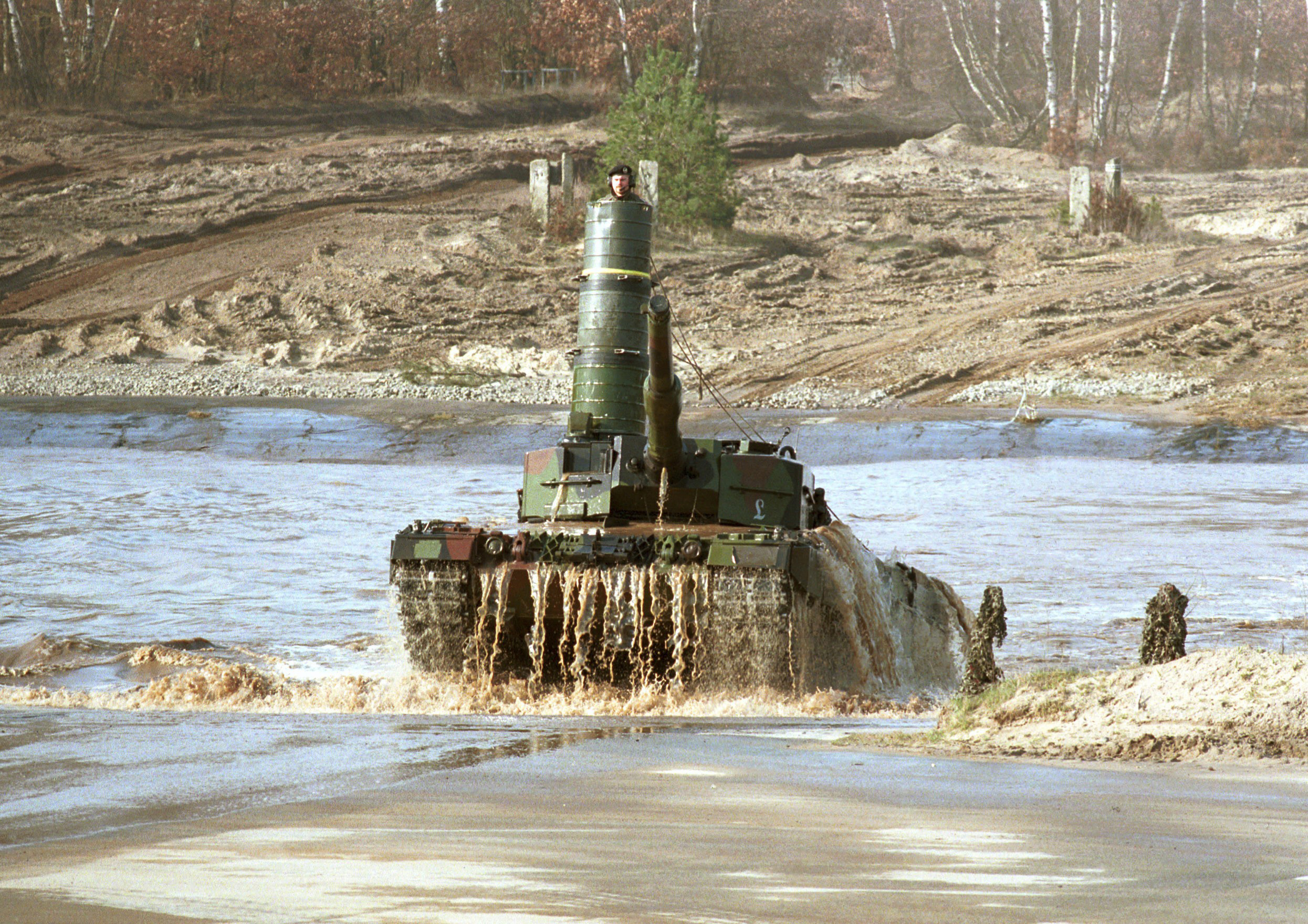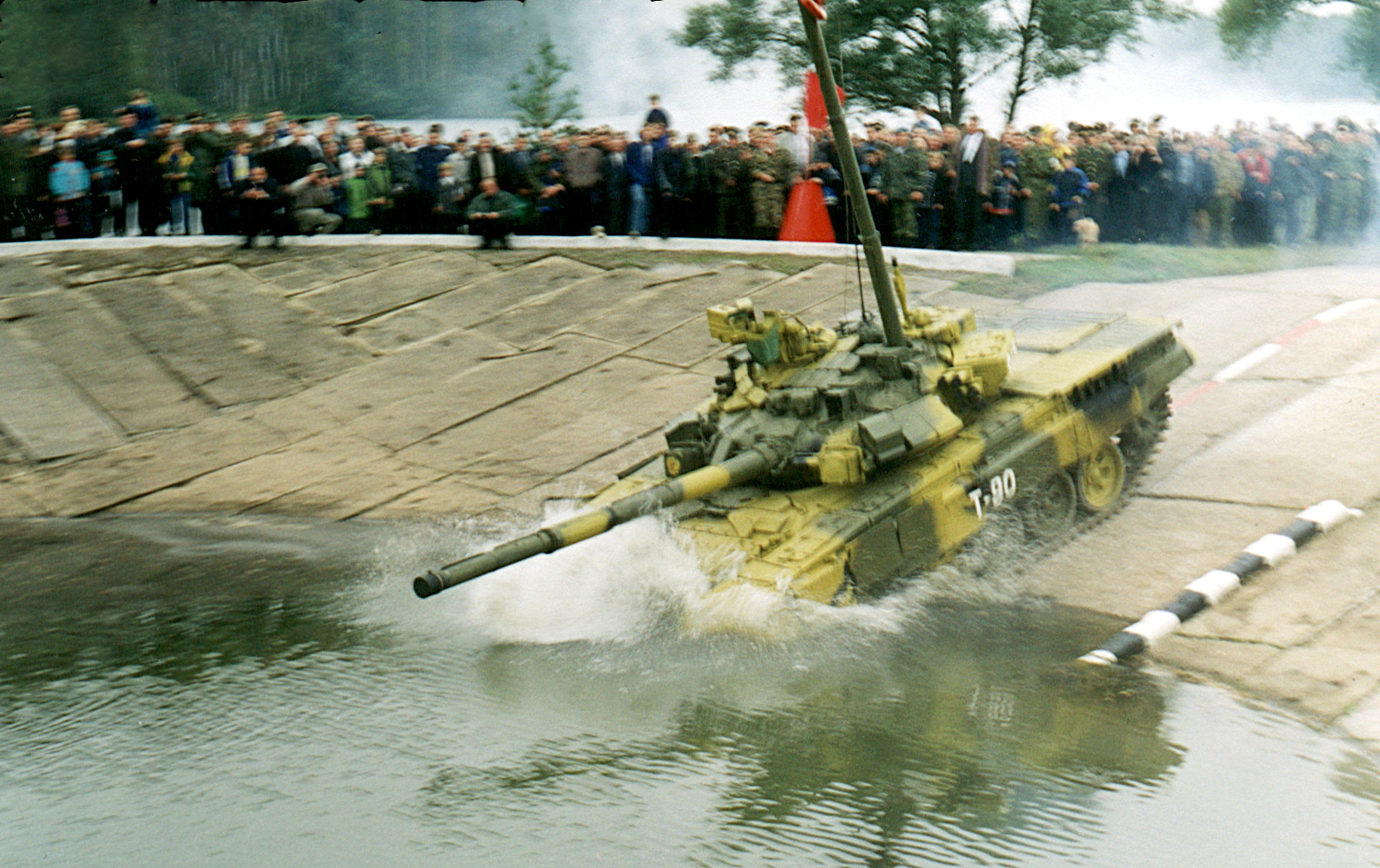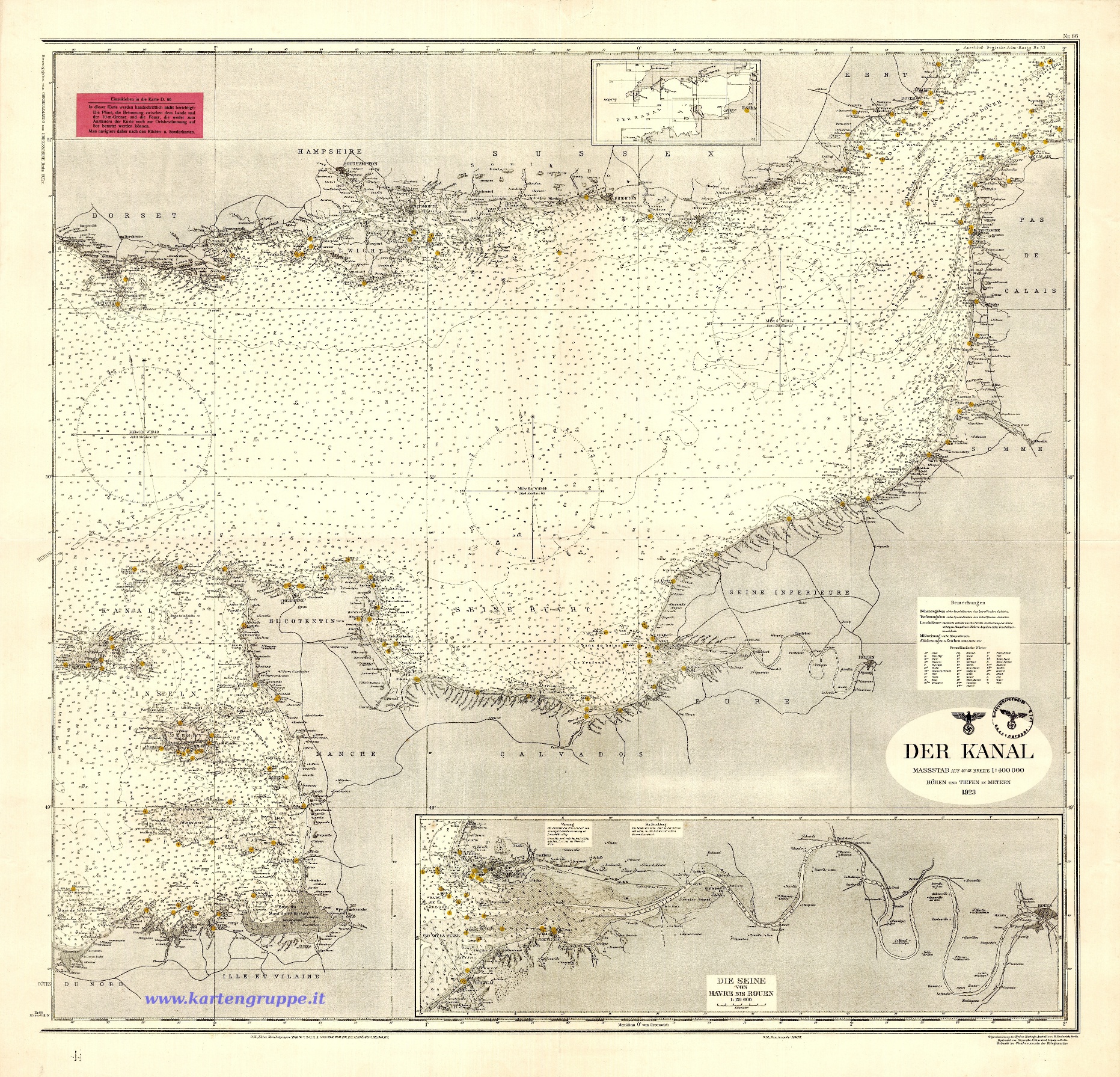|
Deep Wading
Deep wading or deep fording is a technique used by some heavy semi-amphibious vehicles to traverse water that is several metres deep - the vehicle drives on the riverbed/lakebed/seabed and uses screens or a pipe (a snorkel) that reaches above the water surface for an air supply. The technique has been used by armoured military vehicles such as tanks and armored personnel carriers. Deep fording generally implies driving through water of such a depth that the vehicle is mostly or entirely submerged by the water, sometimes to several times the height of the vehicle itself, as well as a sealed crew compartment, complete with air supply for the crew. This makes it different from the less extreme "wading" done by many off-road vehicles which are simply fitted with a snorkel that is higher than the normal engine air intake, roughly level with the top of the cab. In these cases, the crew compartment is not watertight, and the snorkel provides air only for the engine. Thus maximum height is ... [...More Info...] [...Related Items...] OR: [Wikipedia] [Google] [Baidu] |
Amphibious Vehicles
An amphibious vehicle (or simply amphibian), is a vehicle that is a means of transport viable on land as well as on or under water. Amphibious vehicles include amphibious bicycles, ATVs, cars, buses, trucks, railway vehicles, combat vehicles and hovercraft. Classic landing craft are not amphibious vehicles as they do not offer any real land transportation at all, although they are part of amphibious warfare. Ground effect vehicles, such as ''ekranoplans'', will likely crash on any but the flattest of landmasses so are also not considered to be amphibious vehicles. General technical notes Apart from the distinction in sizes mentioned above, two main categories of amphibious vehicles are immediately apparent: those that travel on an air-cushion (Hovercraft) and those that do not. Amongst the latter, many designs were prompted by the desire to expand the off-road capabilities of land-vehicles to an "all-terrain" ability, in some cases not only focused on creating a transpor ... [...More Info...] [...Related Items...] OR: [Wikipedia] [Google] [Baidu] |
Tiger I
The Tiger I () was a German heavy tank of World War II that operated beginning in 1942 in Africa and in the Soviet Union, usually in independent heavy tank battalions. It gave the German Army its first armoured fighting vehicle that mounted the 8.8 cm KwK 36 gun (derived from the 8.8 cm Flak 36). 1,347 were built between August 1942 and August 1944. After August 1944, production of the Tiger I was phased out in favour of the Tiger II. While the Tiger I has been called an outstanding design for its time, it has also been called overengineered, using expensive materials and labour-intensive production methods. In the early period Tiger was prone to certain types of track failures and breakdowns and was in general limited in range by its high fuel consumption. It was expensive to maintain, but generally mechanically reliable. It was difficult to transport and vulnerable to immobilisation when mud, ice, and snow froze between its overlapping and interleaved ''Schacht ... [...More Info...] [...Related Items...] OR: [Wikipedia] [Google] [Baidu] |
Beach Armoured Recovery Vehicle
A beach armoured recovery vehicle (BARV) is an armoured recovery vehicle used for amphibious landings. There have been three different BARVs in British service since their introduction during World War II. They have also been used by Dutch and Australian forces. Sherman BARV The original BARV was a Sherman M4A2 tank which had been waterproofed and had the turret replaced by a tall armoured superstructure. Around 60 were deployed on the invasion beaches during the Battle of Normandy. Able to operate in 9-foot (2.7 metre) deep water, the BARV was used to remove vehicles that had become broken-down or swamped in the surf and were blocking access to the beaches. They were also used to re-float small landing craft that had become stuck on the beach. Unusually for a tank, the crew included a diver whose job was to attach towing chains to stuck vehicles. The vehicles were developed and operated by the Royal Electrical and Mechanical Engineers. The Sherman M4A2 model was chosen as a ... [...More Info...] [...Related Items...] OR: [Wikipedia] [Google] [Baidu] |
T-90
The T-90 is a third-generation Russian main battle tank. It uses a 125mm 2A46 smoothbore main gun, the 1A45T fire-control system, an upgraded engine, and gunner's thermal sight. Standard protective measures include a blend of steel and composite armour, smoke grenade dischargers, Kontakt-5 explosive reactive armour (ERA) and the Shtora infrared anti-tank guided missile (ATGM) jamming system. The T-90 was designed and built by Uralvagonzavod, in Nizhny Tagil, Russia. It entered service with the Russian Army in 1992. Development The T-90 has its origins in a Soviet-era program aimed at developing a single replacement for the T-64, T-72 and T-80 series of main battle tanks. The T-72 platform was selected as the basis for the new generation of tank owing to its cost-effectiveness, simplicity and automotive qualities. The Kartsev-Venediktov Design Bureau from Nizhny Tagil was responsible for the design work and prepared two parallel proposals—the ''Object 188'', which was a re ... [...More Info...] [...Related Items...] OR: [Wikipedia] [Google] [Baidu] |
T-72
The T-72 is a family of Soviet/Russian main battle tanks that entered production in 1969. The T-72 was a development of the T-64, which was troubled by high costs and its reliance on immature developmental technology. About 25,000 T-72 tanks have been built, and refurbishment has enabled many to remain in service for decades. It has been widely exported and has seen service in 40 countries and in numerous conflicts. The T-90 introduced in 1992 is a development of the T-72B; production and development of various modernized T-72 models continues today. Development Development from the T-64 The T-72 was a product of a rivalry between design teams. Morozov KB was led by Alexander Morozov in Kharkiv. Uralvagon KB was led by Leonid Kartsev in Nizhny Tagil. To improve on the T-62, two designs based on the tank were tested in 1964: Nizhny Tagil's Object 167 (T-62B) and Kharkiv's Object 434. Ob. 434 was a technically ambitious prototype. Under the direction of Morozov in Kharkiv, a ... [...More Info...] [...Related Items...] OR: [Wikipedia] [Google] [Baidu] |
T-54/55
The T-54 and T-55 tanks are a series of Soviet main battle tanks introduced in the years following the Second World War. The first T-54 prototype was completed at Nizhny Tagil by the end of 1945.Steven Zaloga, T-54 and T-55 Main Battle Tanks 1944–2004, p. 6 From the late 1950s, the T-54 eventually became the main tank for armoured units of the Soviet Army, armies of the Warsaw Pact countries, and many others. T-54s and T-55s have been involved in many of the world's armed conflicts since their introduction in the second half of the 20th century. The T-54/55 series is the most-produced tank in history. Estimated production numbers for the series range from 96,500 to 100,000. They were replaced by the T-62, T-64, T-72, T-80 and T-90 tanks in the Soviet and Russian armies, but remain in use by up to 50 other armies worldwide, some having received sophisticated retrofitting. During the Cold War, Soviet tanks never directly faced their NATO adversaries in combat in Europe. Ho ... [...More Info...] [...Related Items...] OR: [Wikipedia] [Google] [Baidu] |
Leopard 2
The Leopard 2 is a 3rd generation main battle tank originally developed by Krauss-Maffei in the 1970s for the West German army. The tank first entered service in 1979 and succeeded the earlier Leopard 1 as the main battle tank of the West German Army. It is armed with a 120 mm smoothbore cannon, and is powered by a V-12 twin-turbo diesel engine. Various versions have served in the armed forces of Germany and 13 other European countries, as well as several non-European nations, including Canada, Chile, Indonesia, and Singapore. The Leopard 2 was used in Kosovo with the German Army, in Afghanistan with the Dutch, Danish and Canadian contributions to the International Security Assistance Force, and saw action in Syria with the Turkish Armed Forces. There are two main development batches of the tank: the original models up to Leopard 2A4, which have vertically faced turret armour, and the improved batch, namely the Leopard 2A5 and newer versions, which have angled arrow-shape ... [...More Info...] [...Related Items...] OR: [Wikipedia] [Google] [Baidu] |
Zwei Leopard 2A5 Beim Durchqueren Eines Gewässer ''
{{disambig ...
Zwei (German: "two") may refer to: * Zwei (band), a Japanese duo band * ZWEI, a text editor * '' Zwei: The Arges Adventure'', 2001 video game * '' Zwei: The Ilvard Insurrection'', 2008 video game * Zwei, a team in ''Infinite Ryvius'' anime series * Zwei, a character in ''Phantom of Inferno'' anime series * Zwei, a Pembroke Welsh Corgi in the anime series ''RWBY''. * ''Project Zwai'', the codename for the video game ''The Evil Within ''The Evil Within'' is a survival horror video game developed by Tango Gameworks and published by Bethesda Softworks. The game was directed by ''Resident Evil'' series creator Shinji Mikami and was released worldwide in October 2014 for PlayStat ... [...More Info...] [...Related Items...] OR: [Wikipedia] [Google] [Baidu] |
Operation Sea Lion
Operation Sea Lion, also written as Operation Sealion (german: Unternehmen Seelöwe), was Nazi Germany's code name for the plan for an invasion of the United Kingdom during the Battle of Britain in the Second World War. Following the Battle of France, Adolf Hitler, the German Führer and Supreme Commander of the Armed Forces, hoped the British government would accept his offer to end the war, and he reluctantly considered invasion only as a last resort if all other options failed. As a precondition, Hitler specified the achievement of both air and naval superiority over the English Channel and the proposed landing sites, but the German forces did not achieve either at any point during the war, and both the German High Command and Hitler himself had serious doubts about the prospects for success. Nevertheless, both the German Army and Navy undertook a major programme of preparations for an invasion: training troops, developing specialised weapons and equipment, and modifyin ... [...More Info...] [...Related Items...] OR: [Wikipedia] [Google] [Baidu] |
Panzer IV
The ''Panzerkampfwagen'' IV (Pz.Kpfw. IV), commonly known as the ''Panzer'' IV, was a German medium tank developed in the late 1930s and used extensively during the Second World War. Its ordnance inventory designation was Sd.Kfz. 161. The Panzer IV was the most numerous German tank and the second-most numerous German fully tracked armoured fighting vehicle of the Second World War; 8,553 Panzer IVs of all versions were built during World War II, only exceeded by the StuG III assault gun with 10,086 vehicles. Its chassis was also used as the base for many other fighting vehicles, including the Sturmgeschütz IV assault gun, the Jagdpanzer IV self-propelled anti-tank gun, the ''Wirbelwind'' self-propelled anti-aircraft gun, and the '' Brummbär'' self-propelled gun. The Panzer IV saw service in all combat theatres involving Germany and was the only German tank to remain in continuous production throughout the war. It was originally designed for infantry support, while the sim ... [...More Info...] [...Related Items...] OR: [Wikipedia] [Google] [Baidu] |
Panzer III
The ''Panzerkampfwagen III'', commonly known as the Panzer III, was a medium tank developed in the 1930s by Germany, and was used extensively in World War II. The official German ordnance designation was Sd.Kfz. 141. It was intended to fight other armoured fighting vehicles and serve alongside and support the similar Panzer IV, which was originally designed for infantry support. However, as the Germans faced the formidable T-34, more powerful anti-tank guns were needed, and since the Panzer IV had more development potential with a larger turret ring, it was redesigned to mount the long-barrelled 7.5 cm KwK 40 gun. The Panzer III effectively swapped roles with the Panzer IV, as from 1942 the last version of the Panzer III mounted the 7.5 cm KwK 37 L/24 that was better suited for infantry support. Production of the Panzer III ceased in 1943. Nevertheless, the Panzer III's capable chassis provided hulls for the Sturmgeschütz III assault gun until the end of the war. Development h ... [...More Info...] [...Related Items...] OR: [Wikipedia] [Google] [Baidu] |
Tauchpanzer
Operation Sea Lion, also written as Operation Sealion (german: Unternehmen Seelöwe), was Nazi Germany's code name for the plan for an invasion of the United Kingdom during the Battle of Britain in the Second World War. Following the Battle of France, Adolf Hitler, the German Führer and Supreme Commander of the Armed Forces, hoped the British government would accept his offer to end the war, and he reluctantly considered invasion only as a last resort if all other options failed. As a precondition, Hitler specified the achievement of both air superiority, air and naval superiority over the English Channel and the proposed landing sites, but the German forces did not achieve either at any point during the war, and both Oberkommando der Wehrmacht, the German High Command and Hitler himself had serious doubts about the prospects for success. Nevertheless, both the German Army and Navy undertook a major programme of preparations for an invasion: training troops, developing specia ... [...More Info...] [...Related Items...] OR: [Wikipedia] [Google] [Baidu] |

.jpg)


.jpg)





